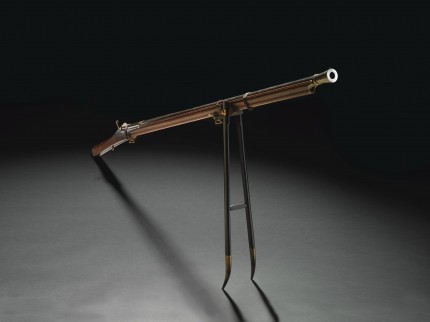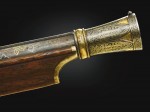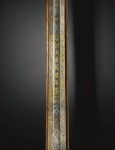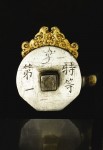
An imperial musket custom-made for the Qianlong Emperor (1711-1799) and marked with the unique ranking of “Supreme Grade, Number One” sold at a Sotheby’s London auction on November 9th for a £1,985,000 ($2,638,000). This is the first Chinese firearm with an imperial reign mark to appear at auction, and the bidding was fierce. The winning bid, almost half a million pounds above the high estimate, was made by an Asian private collector.
 The Qianlong Emperor was an avid collector of art and had a great interest in Western technology. Western firearms captured his fancy not for waging war, but for hunting. Their great length required a tripod for shooting, which is not the most convenient weaponry for battle. Its firepower was far more effective than a bow and arrow for hunting, however, and the stationary position was fine once the target was acquired.
The Qianlong Emperor was an avid collector of art and had a great interest in Western technology. Western firearms captured his fancy not for waging war, but for hunting. Their great length required a tripod for shooting, which is not the most convenient weaponry for battle. Its firepower was far more effective than a bow and arrow for hunting, however, and the stationary position was fine once the target was acquired.
The Qianlong Emperor, one of the most powerful Sons of Heaven and the longest-lived and de-facto longest-reigning emperor in Chinese history, deeply admired his grandfather, the Kangxi Emperor (r. 1662-1722), and like him, was proud of his Manchu ancestry and at the same time keenly interested in Western technology. Both were intent on keeping in touch with a Manchu life style, organized large-scale training hunts at Rehe (Jehol), Chengde, northeast of Beijing, with soldiers from the Eight Banners, to keep their troops well trained for military campaigns, and prided themselves on their own hunting, riding and shooting skills. Organized hunting trips were also a way of building closer relations with Mongolian princes who usually participated in these hunts. While traditionally, hunting would have been done with bow and arrow, or with spears, the advent of Western firearm technology sparked off the production of muskets also in the imperial workshops.
 The emperor’s love of hunting was well known and represented in art. Giuseppe Castiglione, the Italian Jesuit missionary who became a court artist who famously sculpted the 12 animals of the Chinese zodiac for a water clock at the Old Summer Palace that were looted by the British in 1860 and wound up in European collections, depicted the Qianlong Emperor calling deer with a large party in a hilly terrain. One anonymous court painter captures the emperor shooting deer with a musket on a tripod much like the one that sold at auction. There’s an even a poem written by the emperor himself when he was 88 years old about how he could still shoot a deer with perfect aim.
The emperor’s love of hunting was well known and represented in art. Giuseppe Castiglione, the Italian Jesuit missionary who became a court artist who famously sculpted the 12 animals of the Chinese zodiac for a water clock at the Old Summer Palace that were looted by the British in 1860 and wound up in European collections, depicted the Qianlong Emperor calling deer with a large party in a hilly terrain. One anonymous court painter captures the emperor shooting deer with a musket on a tripod much like the one that sold at auction. There’s an even a poem written by the emperor himself when he was 88 years old about how he could still shoot a deer with perfect aim.
 The Supreme Number One matchlock musket was one of very few made by the Manufacture Department of the Imperial Household for the Qianlong Emperor using the most expensive materials. The stock is elm wood. The barrel is cast iron inlaid with gold, silver and copper foliage decoration. The muzzle is also cast iron and is inlaid with the gold mark of the Qianlong Emperor. Behind the breech, visible only if the musket is taken apart, is the inscription “te deng di yi” (Supreme Grade Number One). It comes with its original tripod of rare zitan wood (red sandalwood native to India) with pointy horn-shaped feet made of cast iron.
The Supreme Number One matchlock musket was one of very few made by the Manufacture Department of the Imperial Household for the Qianlong Emperor using the most expensive materials. The stock is elm wood. The barrel is cast iron inlaid with gold, silver and copper foliage decoration. The muzzle is also cast iron and is inlaid with the gold mark of the Qianlong Emperor. Behind the breech, visible only if the musket is taken apart, is the inscription “te deng di yi” (Supreme Grade Number One). It comes with its original tripod of rare zitan wood (red sandalwood native to India) with pointy horn-shaped feet made of cast iron.
 The Supreme Grade Number One designation is unique among the imperial muskets that have survived. It is likely connected to six imperial muskets now in the collection of Beijing’s Palace Museum. They have individual names that appear on a list of seven in the Qing-era record Collected Statutes of the Qing Dynasty with Illustrations. They were likely given graded as well, although the inscriptions are not extant.
The Supreme Grade Number One designation is unique among the imperial muskets that have survived. It is likely connected to six imperial muskets now in the collection of Beijing’s Palace Museum. They have individual names that appear on a list of seven in the Qing-era record Collected Statutes of the Qing Dynasty with Illustrations. They were likely given graded as well, although the inscriptions are not extant.
Chinese Actor Wang Gang recites the Qianlong Emperor’s poem on hunting deer with one of his prized muskets:
The exhibition in the ‘Veste’ hill fortress in Coburg showcases some massive antique hunting muskets, measuring more than 2 meters, maybe up to 3 meters. From a sportsmanship point of view, the nobleman used to fire a broadside, for example into a swarm of flying partridges and then waited what would finally trickle down.
They also have artillery galore, and I found the website of a gunsmith from the area. They seem to specialize also in reenactment, even in Coburg.
“Bipod” (2 legs/feet), not “tripod” (3 legs/feet).
Also, the barrel is almost certainly made of wrought (forged with a hammer)iron rather than cast (cast in a mould) iron which is much more brittle. I would not have wanted to be the gun smith who had his cast iron barrel blow up and injure or kill the Emperor. I realize that the news article or auction catalog describing this piece may have mis-described it but as a blacksmith and firearm history geek I have pick nits.
That it’s a matchlock in itself is unusual as the matchlock was just about extinct at the time this musket was made, with the flintlock making it’s ascendancy.